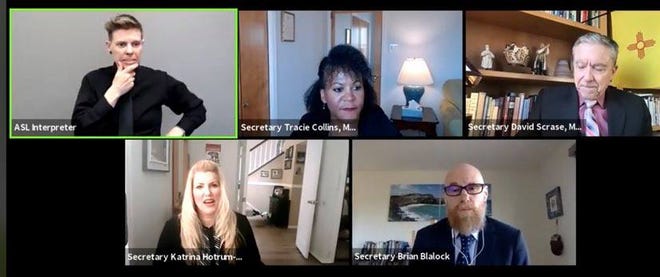New Mexico officials say state's handling of COVID-19 saved lives

ALBUQUERQUE – New Mexico is stronger having been through the challenges, grief and anxiety brought on by the coronavirus pandemic, Gov. Michelle Lujan Grisham said Thursday as she acknowledged the upheaval and uncertainty over the past 12 months.
It has been a year since the World Health Organization declared COVID-19 a pandemic. In that time, New Mexico has recorded nearly 190,000 COVID-19 cases and more than 3,800 deaths. Hospitals were pushed to the brink of having to ration care, unemployment ballooned, schools raced to adopt virtual learning, many businesses had to shut their doors for good and families mourned the loss of loved ones.
The Democratic governor said in a statement that the strength of health care and other front-line workers, parents, educators and others has been a source of optimism.
“Having weathered the storm, we will take stock of our surroundings, understand we are stronger for having been through it and begin again in earnest the focused work of transforming our state for the benefit of all families and workers,” Lujan Grisham said.
The governor and members of her Cabinet have defended the state’s handling of the pandemic over the past year.
More:Our view: What COVID-19 took from New Mexico, and what it showed us
Dr. David Scrase, head of the state Human Services Department, said tough public health restrictions early on — such as mask-wearing and banning public gatherings — along with testing, contact tracing and vaccination put New Mexico in a better position than many other states.
A collaborative effort by state agencies and private health care providers to address the pandemic on a statewide level rather than individually also helped, he said.
Without the combined efforts, he said modeling shows New Mexico would have seen more than 1.8 million infections, six times the number of hospitalizations and four times the number of deaths.
“Knowing that we have saved over 15,000 New Mexican lives is incredibly gratifying for every state of New Mexico and health care employee,” he said.
For every new infection, Scrase said about 50 people are being vaccinated and that vaccinations now account for lowering the incidence of new cases by more than 60%.
When the pandemic began, the scientific literature on COVID-19 was absent and very little information was coming out of China, Scrase said. One of the state’s biggest challenges was to collect as much data as possible, build new information technology systems, databases and dashboards and assemble a medical advisory team.
“So I think that initial guidance about being science and data orientated really set the tone for what we did, and we’re making some really effective decisions now as a result of having that data,” Scrase said.
More:New Mexico health department moves 60-year-olds with chronic conditions up in vaccine line
Some Republican lawmakers said Thursday that the governor’s health orders were issued unilaterally with no input from the Legislature or the public.
“Today, the governor and her administration are doing a victory lap, applauding one another and patting themselves on the back,” Senate Republican leadership said in a statement. “Though as we look back on this past year, we are disheartened — disheartened that our students have lost a year of education, that many of our citizens have lost a year of employment, and that too many New Mexicans have lost everything they have ever worked for.”
Officials with the state’s largest health care providers also reflected on Thursday’s milestone, calling it a somber day. They talked about being terrified last March and April as they braced for the first wave of COVID-19 cases in a state that already had issues with access to care and a lack of hospital beds.
Lillian Montoya, the CEO of Christus St. Vincent Regional Medical Center in Santa Fe, said health care workers and hospitals were tested in unimaginable ways but that working together resulted in a new way of doing business to ensure people could get the care they needed.
That meant constant meetings, phone calls and emails among hospitals to juggle patients and equipment such as ventilators. It also meant sharing data and ideas.
“That was a beautiful thing,” she said. “When you think about the last 12 months, every single hospital in this state cared for patients from another community other than their own. It was incredible.”
More:Doña Ana County jury trial backlog due to COVID-19 could take years to overcome
Despite the spread of the virus easing, health officials said they are still cautious and will be watching any trends that develop as more commercial and day-to-day activities resume. They also pointed to spring break, the upcoming Easter holiday and students returning to school.
“Watchful and waiting is definitely the mode of right now,” University of New Mexico Hospitals CEO Kate Becker said. “The more vaccinations we can deliver, the less worrisome all of this becomes.”
State data shows more than 1.6 million New Mexicans over 16 — or about three-quarters of the population — are eligible to be vaccinated. About 707,000 doses have been administered so far.